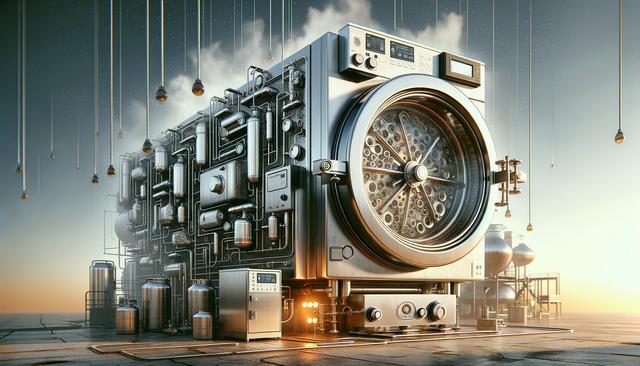Understanding the Role of Autoclaves in Industrial Sterilization
Autoclaves are specialized pressure chambers that use high-temperature steam to sterilize materials efficiently and reliably. Originally developed for medical and laboratory environments, autoclave technology has expanded into a wide range of industrial uses, including pharmaceutical manufacturing, food processing, and materials testing. The core principle behind autoclaving is the combination of heat, moisture, and elevated pressure to eliminate microorganisms, spores, and other contaminants from tools, components, and packaging materials. This method ensures that industrial processes maintain strict hygiene standards and comply with safety regulations.
One of the key advantages of autoclave technology is its ability to sterilize complex items that would otherwise be damaged by conventional dry heat or chemical methods. These include items such as sealed containers, intricate mechanical parts, and heat-sensitive instruments. In industrial settings, autoclaves are used not only for sterilization but also for curing composite materials and vulcanizing rubber, demonstrating their versatility. The reliability and repeatability of autoclave sterilization make it a trusted solution across diverse sectors where contamination control is critical.
Types of Autoclaves and Their Industrial Applications
Autoclaves come in various types and configurations, each designed to meet specific industrial needs. The most common types include:
- Gravity displacement autoclaves: Ideal for basic sterilization tasks where air removal is not a major concern.
- Pre-vacuum autoclaves: Use vacuum pumps to remove air before the steam cycle begins, ensuring deeper steam penetration into porous materials.
- Horizontal and vertical autoclaves: Configured based on space availability and volume of materials to be sterilized.
- Continuous autoclaves: Designed for high-throughput operations, often used in food processing and large-scale manufacturing.
Each type of autoclave is selected based on the nature of the materials being sterilized and the requirements of the specific industry. For instance, the pharmaceutical industry often relies on pre-vacuum models to ensure thorough sterilization of ampoules and vials. Meanwhile, the aerospace and automotive sectors use autoclaves for curing composite components, capitalizing on the controlled temperature and pressure environments these chambers provide.
Key Features and Operating Principles
The effectiveness of an autoclave depends on several core features that allow it to maintain consistent sterilization conditions. These include:
- High-pressure steam generation: Typically operates at pressures between 15 and 30 psi to reach sterilization temperatures of 121°C to 134°C.
- Temperature and pressure sensors: Ensure that the process adheres to precise sterilization protocols.
- Safety interlocks and user controls: Prevent the chamber from opening while under pressure, enhancing safety.
- Programmable cycles: Allow operators to tailor sterilization times and conditions based on the load type.
The operating cycle of an autoclave typically involves a pre-conditioning phase, steam injection, a holding period at the target temperature and pressure, and finally, an exhaust or drying phase. This sequence ensures the elimination of microorganisms across the load while preserving the integrity of the materials being processed. Industrial-grade autoclaves are often equipped with data logging capabilities to aid in quality control and traceability.
Benefits of Autoclave Sterilization in Industrial Settings
Autoclave technology offers numerous benefits that make it suitable for demanding industrial environments. Some of the most significant advantages include:
- Consistent, high-level sterilization: Reaches and maintains conditions that destroy the most resistant pathogens and spores.
- Eco-friendly: Reduces reliance on chemical sterilants, which can be harmful to both workers and the environment.
- Durability and scalability: Industrial autoclaves are built to handle large volumes and frequent use, providing long-term value.
- Compliance with regulations: Meets stringent industry standards, including those set by regulatory bodies for pharmaceuticals, food safety, and manufacturing.
These advantages contribute to enhanced product safety, reduced risk of contamination, and improved operational efficiency. Additionally, the ability to sterilize reusable components helps industries lower material costs and minimize waste, aligning with sustainability goals.
Maintenance and Operational Considerations
To ensure optimal performance, industrial autoclaves require routine maintenance and monitoring. Regular inspections help identify wear and tear on pressure seals, valves, and heating elements. Calibration of sensors and controllers is also essential to maintain accuracy over time. Operators must be trained not only in the safe use of autoclaves but also in recognizing signs of malfunction or inefficiency.
Key maintenance practices include:
- Scheduled cleaning of the chamber and drainage systems to prevent buildup of residues.
- Checking for steam leaks or pressure inconsistencies.
- Verifying that safety interlocks and alarms are functioning properly.
- Reviewing data logs for any deviations from standard cycles.
By implementing a preventive maintenance program and adhering to manufacturer guidelines, industries can extend the lifespan of their autoclaves and maintain high levels of operational reliability. This proactive approach also helps avoid costly downtime and ensures continuous compliance with health and safety standards.
Conclusion: A Dependable Solution for Industrial Sterilization Needs
Autoclave technology continues to prove itself as a dependable and efficient method of sterilization across a variety of industrial sectors. Its ability to deliver consistent results, handle a wide range of materials, and meet strict regulatory requirements makes it an essential tool for contamination control and product integrity. Whether in pharmaceuticals, aerospace, or food production, autoclaves help businesses maintain quality and safety standards while optimizing their operational processes. Investing in high-quality autoclave systems and maintaining them properly ensures long-term reliability and supports the rigorous demands of modern industrial environments.




Leave a Reply